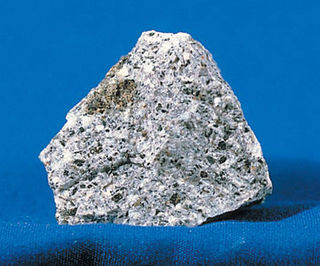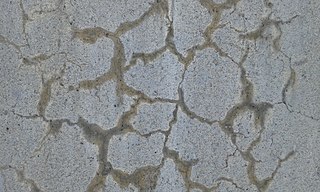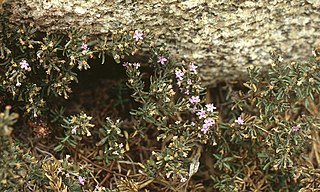In chemistry, an alkali is a basic, ionic salt of an alkali metal or alkaline earth metal chemical element. An alkali also can be defined as a base that dissolves in water. A solution of a soluble base has a pH greater than 7.0. The adjective alkaline is commonly, and alkalescent less often, used in English as a synonym for basic, especially for bases soluble in water. This broad use of the term is likely to have come about because alkalis were the first bases known to obey the Arrhenius definition of a base, and they are still among the most common bases.

Syenite is a coarse-grained intrusive igneous rock with a general composition similar to that of granite, but deficient in quartz, which, if present at all, occurs in relatively small concentrations. Some syenites contain larger proportions of mafic components and smaller amounts of felsic material than most granites; those are classed as being of intermediate composition. The volcanic equivalent of syenite is trachyte.

In chemistry, bases are substances that, in aqueous solution, release hydroxide (OH−) ions, are slippery to the touch, can taste bitter if an alkali, change the color of indicators (e.g., turn red litmus paper blue), react with acids to form salts, promote certain chemical reactions (base catalysis), accept protons from any proton donor or contain completely or partially displaceable OH− ions. Examples of bases are the hydroxides of the alkali metals and the alkaline earth metals (NaOH, Ca(OH)2, etc.—see alkali hydroxide and alkaline earth hydroxide).

Sodium carbonate, Na2CO3, (also known as washing soda, soda ash and soda crystals) is the inorganic compound with the formula Na2CO3 and its various hydrates. All forms are white, water-soluble salts. All forms have a strongly alkaline taste and give moderately alkaline solutions in water. Historically it was extracted from the ashes of plants growing in sodium-rich soils. Because the ashes of these sodium-rich plants were noticeably different from ashes of wood (once used to produce potash), sodium carbonate became known as "soda ash". It is produced in large quantities from sodium chloride and limestone by the Solvay process.

Nepheline syenite is a holocrystalline plutonic rock that consists largely of nepheline and alkali feldspar. The rocks are mostly pale colored, grey or pink, and in general appearance they are not unlike granites, but dark green varieties are also known. Phonolite is the fine-grained extrusive equivalent.

Masa is a maize dough that comes from ground nixtamalized corn. It is used for making corn tortillas, gorditas, tamales, pupusas, and many other Latin American dishes. Its dried and powdered form is called masa harina, masa de harina, and sometimes Maseca, the name of one commercial brand. The flour is reconstituted with water to make a dough before it is used in cooking.

Nixtamalization is a process for the preparation of maize (corn), or other grain, in which the corn is soaked and cooked in an alkaline solution, usually limewater, washed, and then hulled. This process is known to remove up to 97–100% of aflatoxins from mycotoxin-contaminated corn. The term can also refer to the removal via an alkali process of the pericarp from other grains such as sorghum.
Alkali is a specific type of chemical base.
The tholeiitic magma series, named after the German municipality of Tholey, is one of two main magma series in igneous rocks, the other being the calc-alkaline series. A magma series is a chemically distinct range of magma compositions that describes the evolution of a mafic magma into a more evolved, silica rich end member. The International Union of Geological Sciences recommends that tholeiitic basalt be used in preference to the term "tholeiite".
Alkali salts or basic salts are salts that are the product of the neutralization of a strong base and a weak acid.

Aluminosilicate minerals are minerals composed of aluminium, silicon, and oxygen, plus countercations. They are a major component of kaolin and other clay minerals.
The calc-alkaline magma series is one of two main subdivisions of the subalkaline magma series, the other subalkaline magma series being the tholeiitic. A magma series is a series of compositions that describes the evolution of a mafic magma, which is high in magnesium and iron and produces basalt or gabbro, as it fractionally crystallizes to become a felsic magma, which is low in magnesium and iron and produces rhyolite or granite. Calc-alkaline rocks are rich in alkaline earths and alkali metals and make up a major part of the crust of the continents.

Alkali–aggregate reaction is a term mainly referring to a reaction which occurs over time in concrete between the highly alkaline cement paste and non-crystalline silicon dioxide, which is found in many common aggregates. This reaction can cause expansion of the altered aggregate, leading to spalling and loss of strength of the concrete.

Frankenia salina, often called alkali heath or alkali seaheath, is a perennial herb native to California. It is occasionally found in Nevada and Mexico, but its range is limited. It is uncommon even in the region where it is most likely to be found, just north of the San Francisco Bay Area.
Liming is a process used for parchment or leather processing, in which hides are soaked in an alkali solution. It is performed using a drum and paddle or a pit. Its objectives are:

Alkali, or Alkaline, soils are clay soils with high pH, a poor soil structure and a low infiltration capacity. Often they have a hard calcareous layer at 0.5 to 1 metre depth. Alkali soils owe their unfavorable physico-chemical properties mainly to the dominating presence of sodium carbonate, which causes the soil to swell and difficult to clarify/settle. They derive their name from the alkali metal group of elements, to which sodium belongs, and which can induce basicity. Sometimes these soils are also referred to as alkaline sodic soils.
Alkaline soils are basic, but not all basic soils are alkaline.

The alkali–silica reaction (ASR), more commonly known as "concrete cancer", is a swelling reaction that occurs over time in concrete between the highly alkaline cement paste and the reactive non-crystalline (amorphous) silica found in many common aggregates, given sufficient moisture.
There are currently 118 known chemical elements exhibiting many different physical and chemical properties. Amongst this diversity, scientists have found it useful to use names for various sets of elements, that illustrate similar properties, or their trends of properties. Many of these sets are formally recognized by the standards body IUPAC.
Alkali Lake may refer to:
Saltwater soap, also called sailors' soap, is a potassium-based soap for use with seawater. Inexpensive common commercial soap will not lather or dissolve in seawater due to high levels of sodium chloride in the water. Similarly, common soap does not work as well as potassium-based soap in hard water where calcium replaces the sodium, making residual insoluble "scum" due to the insolubility of the soap residue. To be an effective cleaning agent, soap must be able to dissolve in water.










